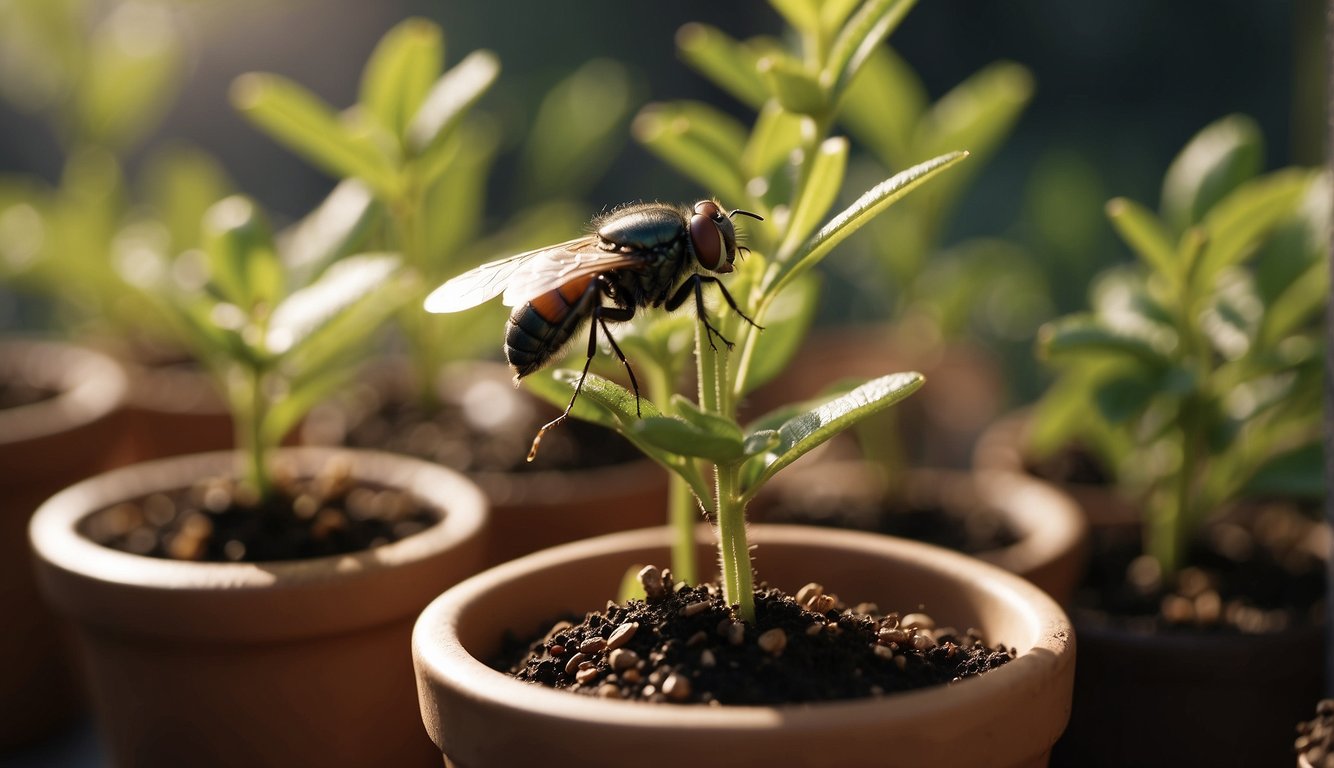TheHerbProf.com is a treasure trove of knowledge for those interested in natural healing and herbal remedies. The website is run by Paul Johnston MD. A naturopathic who has not only received extensive education in the field but also has personal experience in self-healing.
If you’re a plant lover, you know how frustrating it can be to have pesky flies buzzing around your indoor potted plants. Not only can they be annoying, but they can also damage your plants and lay eggs in the soil, leading to even more infestations. Fortunately, there are several effective ways to get rid of flies in potted plants.
One of the most important steps in getting rid of flies in potted plants is to identify the type of fly you’re dealing with. The most common type of fly found in potted plants is the fungus gnat. These tiny, black flies are attracted to moist soil and organic matter, making potted plants a perfect breeding ground. However, other types of flies can also infest your plants, so it’s important to identify the specific type in order to choose the most effective treatment method.
Once you’ve identified the type of fly, there are several methods you can use to get rid of them. Some effective methods include using sticky traps, applying insecticidal soap or neem oil, and using natural remedies such as vinegar or cinnamon. By taking action to get rid of flies in your potted plants, you can help keep your plants healthy and thriving.
Understanding the Problem – How to Get Rid of Flies in Potted Plants?
As a plant lover, it can be frustrating to see flies buzzing around your potted plants. However, before you can effectively get rid of them, it’s important to understand the problem. In this section, I will help you identify the type of flies you are dealing with, understand their life cycle, and explore the reasons for fly infestations in potted plants.
Identify the Type of Flies
The most common types of flies that infest potted plants are fungus gnats and fruit flies. Fungus gnats are small, dark-colored flies that are often mistaken for fruit flies. They are attracted to moist soil and decaying plant matter. Fruit flies, on the other hand, are small, light-colored flies that are attracted to ripe or fermenting fruits and vegetables.
Life Cycle of Common Potted Plant Flies – How to Get Rid of Flies in Potted Plants?
Understanding the life cycle of flies is crucial in getting rid of them. Both fungus gnats and fruit flies have a similar life cycle. They lay eggs in the soil, which hatch into larvae. The larvae feed on organic matter in the soil before pupating and eventually emerging as adults. The entire life cycle can take anywhere from 10 days to several weeks, depending on the species and environmental conditions.
Reasons for Fly Infestations in Potted Plants
Fly infestations in potted plants can be caused by a variety of factors. Overwatering can create a moist environment that is ideal for fly larvae to thrive. Poor drainage and lack of airflow can also contribute to the problem. Additionally, using contaminated soil or bringing infested plants into your home can introduce flies to your potted plants.
Now that we have a better understanding of the problem, we can move on to effective solutions for getting rid of flies in potted plants.
Preventative Measures – How to Get Rid of Flies in Potted Plants?

As the old saying goes, prevention is better than cure. Here are some preventative measures you can take to avoid having flies in your potted plants.
Proper Watering Techniques
Overwatering is one of the leading causes of fly infestations in potted plants. To avoid overwatering, make sure to water your plants only when the soil is dry to the touch. You can also check the moisture level by sticking your finger about an inch into the soil. If it feels dry, it’s time to water.
Choosing the Right Soil and Pot – How to Get Rid of Flies in Potted Plants?
The type of soil and pot you use can also affect the likelihood of fly infestations. Use a potting mix that is well-draining and doesn’t hold onto moisture for too long. Also, make sure your pot has good drainage holes to prevent water from pooling at the bottom.
Regular Plant Maintenance
Regularly maintaining your plants can also help prevent flies from infesting them. Remove any dead leaves or debris that may be sitting on top of the soil, as this can attract flies. Additionally, regularly inspect your plants for any signs of infestation, such as small flies hovering around the soil.
By taking these preventative measures, you can significantly reduce the risk of having flies in your potted plants.
Natural Remedies – How to Get Rid of Flies in Potted Plants?

If you’re looking for natural ways to get rid of flies in potted plants, there are several remedies you can try. Here are a few options:
Using Sticky Traps – How to Get Rid of Flies in Potted Plants?
One of the easiest and most effective ways to control flying insects in potted plants is to use sticky traps. These traps are usually bright yellow, which attracts the flies, and coated with a sticky substance that traps them. You can purchase sticky traps at most garden centers or online. Hang the traps near the infested plants, and replace them every few weeks or as needed.
Neem Oil Applications
Another natural remedy for getting rid of flies in potted plants is neem oil. This oil is derived from the seeds of the neem tree and has insecticidal properties. Mix a few drops of neem oil with water and spray the solution on the plants. Be sure to cover the undersides of the leaves, where flies like to lay their eggs. Repeat the application every week or as needed.
Beneficial Nematodes and Insects
Beneficial nematodes and insects can also help control flies in potted plants. Nematodes are microscopic worms that feed on the larvae of flies and other insects. You can purchase nematodes online or at garden centers and apply them to the soil around the plants. Another option is to introduce beneficial insects, such as ladybugs, which feed on flies and their larvae. You can purchase ladybugs online or at garden centers and release them near the infested plants.
In addition to these remedies, it’s important to keep the soil in your potted plants healthy and free of organic matter and fungi. Flies are attracted to moist, decaying organic matter, so be sure to remove any dead leaves or debris from the soil. Also, make sure your plants are getting the right amount of light and water, as stressed plants are more susceptible to insect infestations. With these natural remedies and proper plant care, you can control flies in your potted plants without the use of harmful pesticides.
Chemical Solutions – How to Get Rid of Flies in Potted Plants?
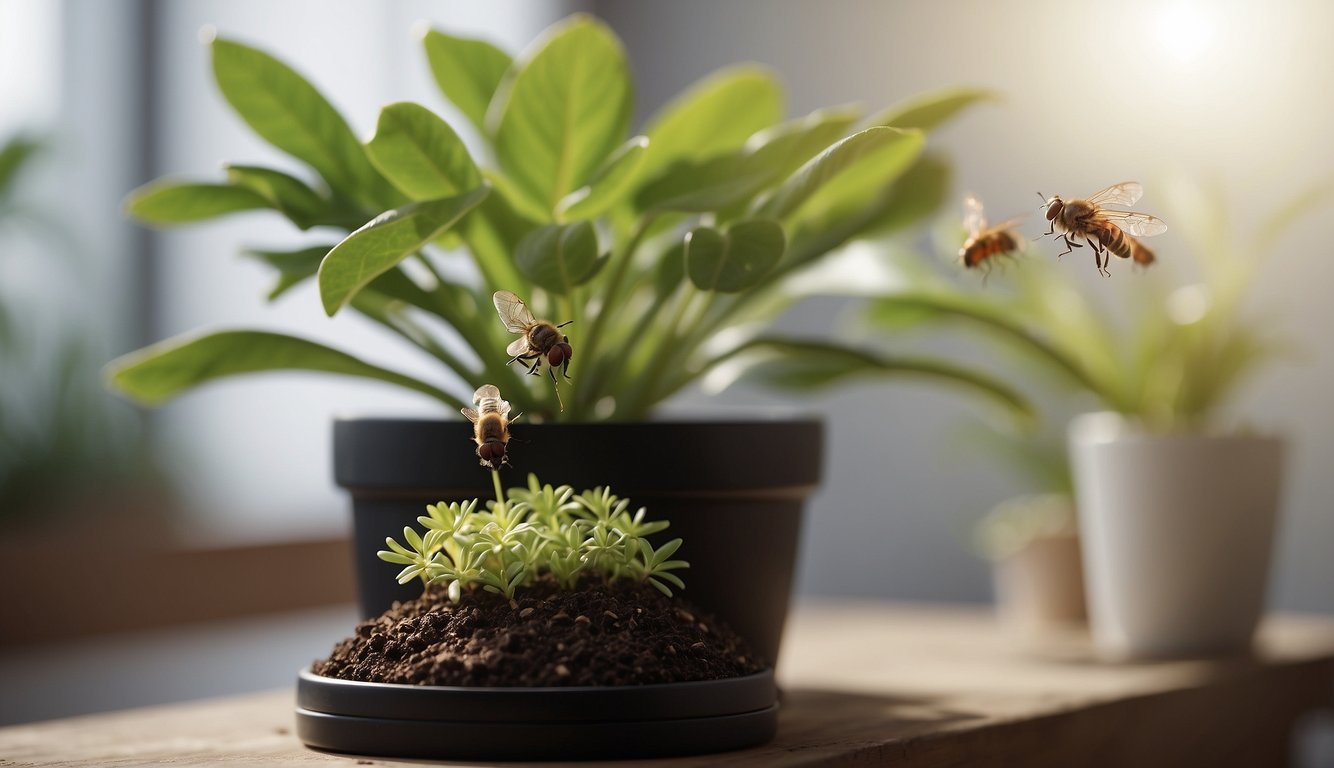
If natural remedies don’t seem to work, there are chemical options available to control flies in potted plants. However, it is important to use them with caution, as some chemicals can harm the plants themselves. Here are some effective chemical solutions to consider:
Insecticidal Soaps and Sprays – How to Get Rid of Flies in Potted Plants?
Insecticidal soaps and sprays are a popular choice for controlling pests in potted plants. They are made from natural ingredients and are less harmful to plants than other chemical options. Insecticidal soaps and sprays work by suffocating the pests, so they are not effective against all types of flies. However, they can be effective against fungus gnats and whiteflies.
When using insecticidal soaps and sprays, it is important to follow the instructions carefully. Apply the solution directly to the plant and avoid spraying it on the soil. It is also important to avoid spraying the solution on the leaves in direct sunlight, as this can cause the leaves to burn.
Systemic Insecticides
Systemic insecticides are another option for controlling flies in potted plants. They work by being absorbed by the plant and then killing the pests when they feed on the plant. Systemic insecticides are effective against a wide range of pests, including flies, but they can be harmful to the plant itself.
When using systemic insecticides, it is important to follow the instructions carefully. Apply the solution directly to the soil, and avoid getting it on the leaves or stems of the plant. It is also important to avoid using systemic insecticides on edible plants, as they can be harmful if ingested.
Chemical solutions can be effective in controlling flies in potted plants, but they should be used with caution. Insecticidal soaps and sprays are a safer option, but they may not be effective against all types of flies. Systemic insecticides are more effective, but they can be harmful to the plant itself. It is important to carefully read and follow the instructions for any chemical solution you choose to use.
Cultural Controls – How to Get Rid of Flies in Potted Plants?
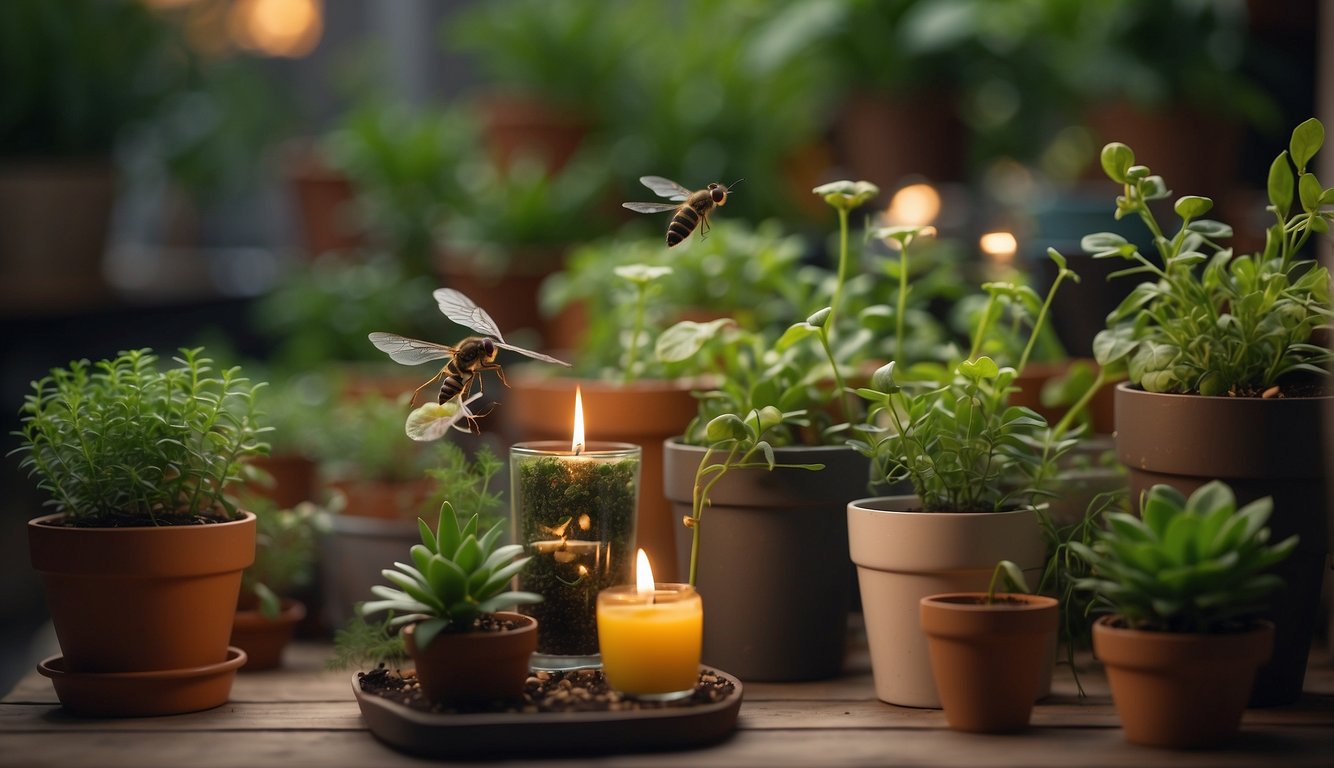
As a plant enthusiast, I know how frustrating it can be to see flies buzzing around your potted plants. Fortunately, there are several cultural controls that you can use to get rid of flies in your potted plants without resorting to harsh chemicals or pesticides.
Environmental Adjustments – How to Get Rid of Flies in Potted Plants?
One of the simplest ways to control flies in your potted plants is to adjust the environment around your plants. Flies are attracted to moist environments, so it’s important to make sure that your plants are not sitting in water. During the winter months, when indoor heating can dry out the air, it’s important to keep the soil in your potted plants moist but not wet. This will help prevent fungus gnats from breeding in the soil.
Another environmental adjustment you can make is to increase the amount of light around your plants. Flies are attracted to dark, damp environments, so increasing the amount of light around your plants can help make them less attractive to flies.
Introducing Predatory Plants
Another effective way to control flies in your potted plants is to introduce predatory plants such as sundews or Venus fly traps. These plants are carnivorous and will feed on flies and other small insects. Placing a few of these plants in your home can help keep the fly population in check.
Cultural controls such as environmental adjustments and introducing predatory plants can be effective ways to control flies in your potted plants. By taking a proactive approach to pest control, you can keep your plants healthy and free of flies without resorting to harsh chemicals or pesticides.
Monitoring and Maintenance – How to Get Rid of Flies in Potted Plants?
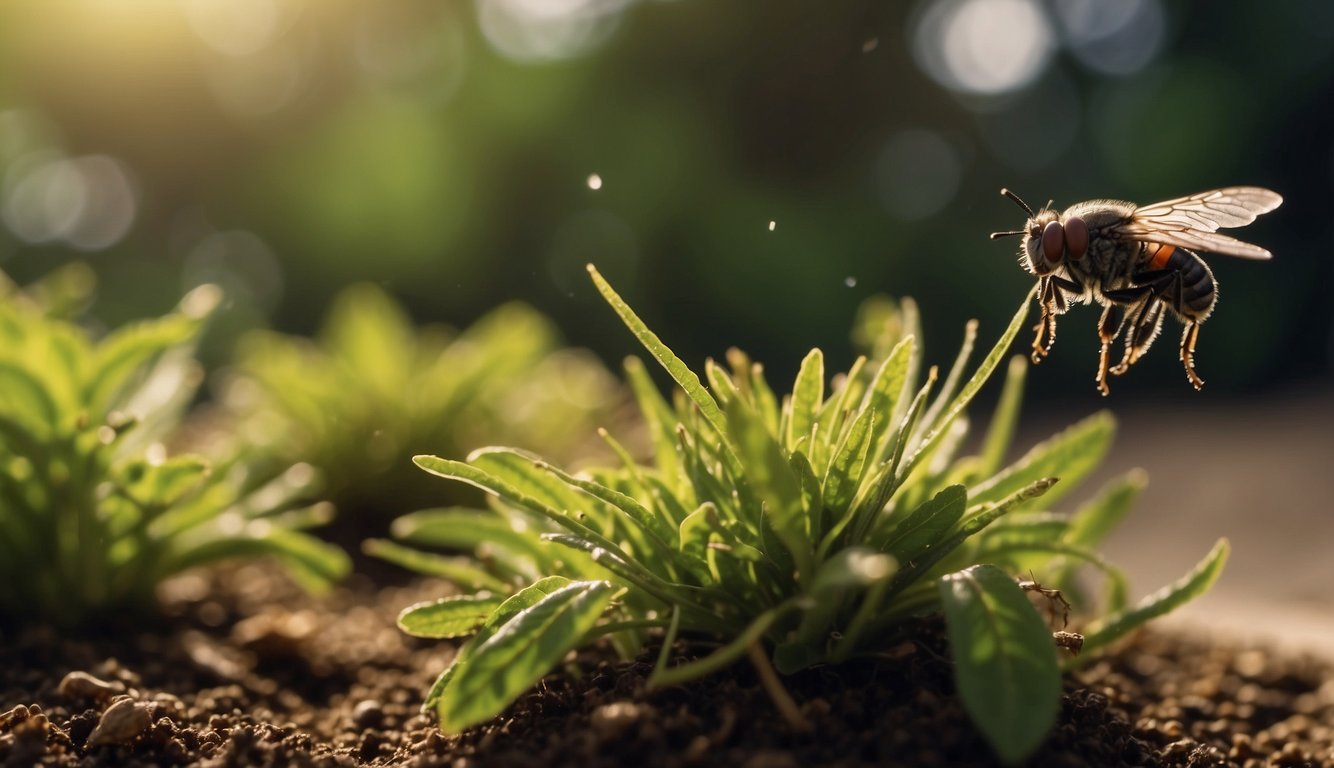
As a plant lover, I understand the importance of regularly inspecting my houseplants to ensure their health and well-being. When it comes to getting rid of flies in potted plants, monitoring and maintenance are crucial steps to take.
Regular Inspection of Plants
Regularly inspecting your plants is essential to catch any signs of flies early on. You can use a magnifying glass to inspect the soil and plant leaves for any signs of flies or their larvae. Look for small, black flies hovering around the plants or crawling on the soil surface.
If you notice any flies, it’s essential to take action immediately. You can use sticky traps or natural remedies like vinegar to get rid of the flies. Regular inspection of your plants will help you catch any signs of flies before they become a full-blown infestation.
Adjusting Care Based on Seasons – How to Get Rid of Flies in Potted Plants?
Adjusting your plant care routine based on the seasons is another crucial step in preventing flies from infesting your plants. During the fall and winter months, you should reduce your watering schedule as plants require less water during this time. Overwatering can lead to excess moisture in the soil, which can attract flies.
On the other hand, during the warmer months, you may need to water your plants more frequently. However, it’s essential to avoid overwatering and ensure proper drainage to prevent flies from infesting your plants.
By adjusting your plant care routine based on the seasons, you can create an environment that’s less hospitable to flies and prevent infestations from occurring.
Overall, monitoring and maintenance are crucial steps in getting rid of flies in potted plants. By regularly inspecting your plants and adjusting your plant care routine based on the seasons, you can prevent flies from infesting your plants and keep them healthy and happy.
Troubleshooting Common Issues – How to Get Rid of Flies in Potted Plants?
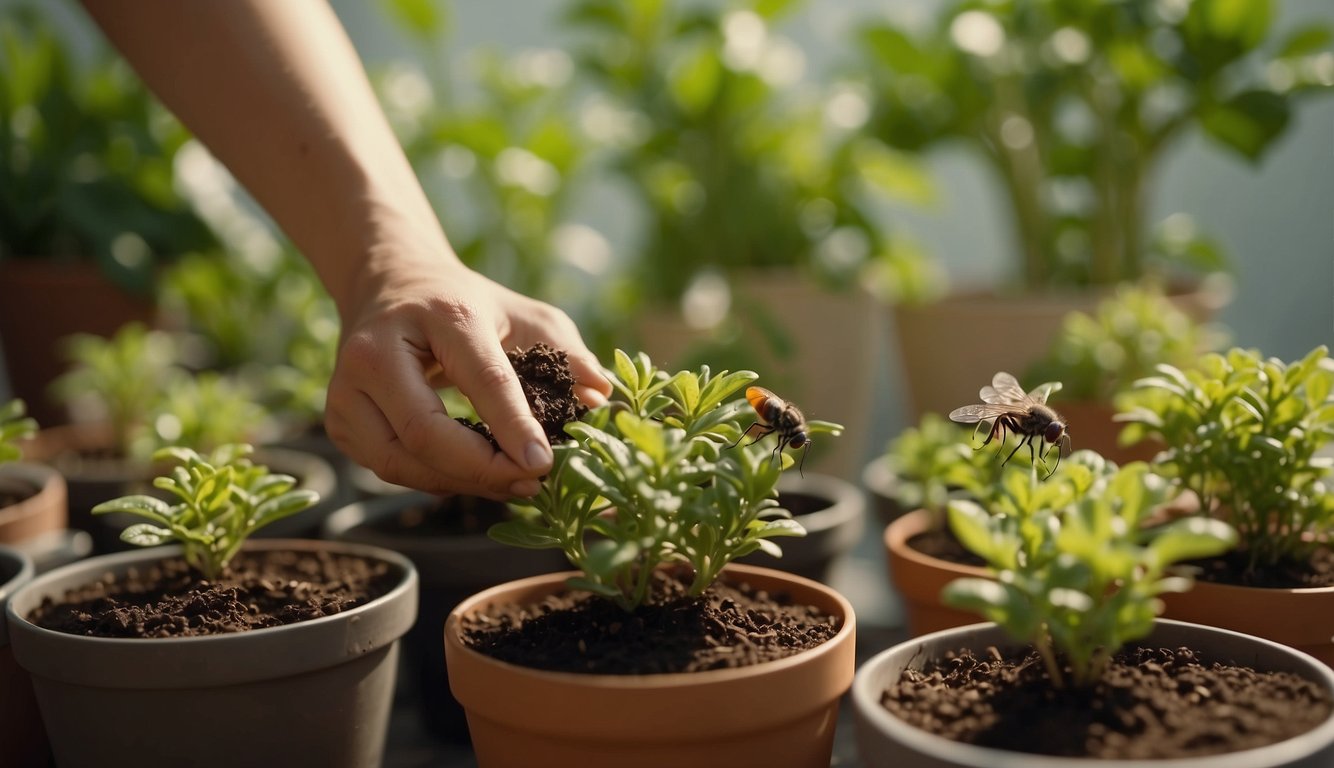
Dealing with Persistent Infestations
If you’ve tried all the methods mentioned above and still can’t get rid of the flies in your potted plants, you might be dealing with a persistent infestation. In such cases, it’s best to consider a more aggressive approach.
One option is to use insecticides, but make sure to choose a product that is safe for plants and follow the instructions carefully. You can also try introducing natural predators like nematodes or predatory mites to your soil, which can help control the fly population.
Addressing Overwatering and Root Rot
Overwatering is a common cause of fly infestations in potted plants. When the soil stays damp for too long, it can lead to root rot, which not only attracts flies but can also harm your plant’s health.
To prevent overwatering, make sure to water your plants only when the top inch of soil feels dry to the touch. Also, avoid leaving excess water in the saucers as this can lead to waterlogged soil.
If you suspect root rot, gently remove your plant from its pot and inspect the roots. Healthy roots should be firm and white, while rotting roots will be soft and brown. If you find any rotting roots, trim them away with clean scissors and repot your plant in fresh, well-draining soil.
By addressing these common issues, you can help prevent fly infestations in your potted plants and keep them healthy and thriving.
Pale Tomato Leaves
Let’s delve into the world of pale tomato leaves and their causes.
Firstly, we have nutrient deficiency. If your tomato leaves are turning pale, they might be crying out for more nutrients!
Next, let’s talk about watering. Too much or too little can stress your plants, leading to pale leaves. Balance is key!
Ever heard of disease? Diseases like blight or wilt can cause your tomato leaves to pale. Keep an eye out for other symptoms!
And let’s not forget sunlight. Tomatoes love the sun, but too much can cause leaf scorch, leading to pale leaves.
Remember, folks, gardening is all about balance. So, let’s keep planting, keep nurturing, and keep enjoying the fruits (and veggies) of our labor!
For more gardening wisdom, don’t forget to visit my homepage at theherbprof.com. Keep those green thumbs up!
References – How to Get Rid of Flies in Potted Plants?
Little Herb Encyclopedia, by Jack Ritchason; N.D., Woodland Publishing Incorporated, 1995
The Ultimate Healing System, Course Manual, Copyright 1985, Don Lepore
Planetary Herbology, Michael Tierra, C.A., N.D., Lotus Press, 1988
Handbook of Medicinal Herbs, by James A. Duke, Pub. CRP Second Edition 2007
The Complete Medicinal Herbal, by Penelope Ody, Published by Dorling Kindersley
Check the Following Articles!
Hoya Plant Bloom: Triggering and Maintaining Blossoms
How to Get Orchids to Rebloom: Tips and Tricks
Pale Tomato Leaves: Causes and Solutions
Frequently Asked Questions – How to Get Rid of Flies in Potted Plants?

What natural remedies are effective for eliminating flies in houseplant soil?
There are several natural remedies that can be used to eliminate flies in houseplant soil. One of the most effective remedies is to use a mixture of water and dish soap. Simply mix a few drops of dish soap with water and pour the mixture into the soil. The soap will break down the surface tension of the water, causing the flies to drown when they land on the soil. Another natural remedy is to use sticky traps. These traps are coated with a sticky substance that attracts flies and prevents them from flying away.
Is it safe to use neem oil on indoor plants to control fly infestations?
Yes, neem oil is safe to use on indoor plants to control fly infestations. Neem oil is a natural insecticide that is derived from the neem tree. It is non-toxic to humans and pets and can be used to control a wide range of pests, including flies. To use neem oil, simply mix a few drops of the oil with water and spray the solution onto the soil and leaves of the plant. The oil will kill the flies and their larvae, preventing them from reproducing.
How can vinegar be used to combat gnat problems in houseplants?
Vinegar can be used to combat gnat problems in houseplants in several ways. One of the most effective ways is to create a vinegar trap. To create the trap, mix a tablespoon of sugar with a tablespoon of vinegar and a few drops of dish soap in a small bowl. Place the bowl near the plant and the gnats will be attracted to the mixture and drown in the liquid. Another way to use vinegar is to mix it with water and pour the solution into the soil. The vinegar will lower the pH of the soil, making it less hospitable to gnats.
What are the quickest methods to eradicate fungus gnats in indoor plant environments?
The quickest methods to eradicate fungus gnats in indoor plant environments include using sticky traps, applying neem oil, and using hydrogen peroxide. Sticky traps are coated with a sticky substance that attracts the gnats and prevents them from flying away. Neem oil is a natural insecticide that can be used to kill the gnats and their larvae. Hydrogen peroxide can be used to kill the larvae in the soil. Simply mix one part hydrogen peroxide with four parts water and pour the solution into the soil.
Are there any specific sprays recommended for targeting small black flies on houseplants?
Yes, there are specific sprays that are recommended for targeting small black flies on houseplants. One of the most effective sprays is pyrethrin spray. Pyrethrin is a natural insecticide that is derived from chrysanthemum flowers. It is safe to use on houseplants and can be sprayed directly onto the flies to kill them. Another effective spray is spinosad. Spinosad is a natural insecticide that is derived from soil bacteria. It is safe to use on houseplants and can be sprayed onto the soil to kill the larvae.
How can one eliminate flies from potted plants without causing harm to the plants themselves?
One way to eliminate flies from potted plants without causing harm to the plants themselves is to use natural remedies. These remedies include using sticky traps, applying neem oil, and using hydrogen peroxide. Another way to eliminate flies is to improve the drainage of the soil. Flies are attracted to moist soil, so by improving the drainage, the soil will become less hospitable to flies. Additionally, it is important to avoid overwatering the plants, as this can lead to stagnant water that attracts flies.
